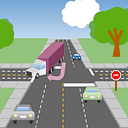I hope I can clear this up. The accident example is a good one to start from.
You can't pay attention to traffic before you know that there is a "traffic" to pay attention to. So how do you gain this concept? The point of this post is that the trigger for noticing something isn't the thing itself, it is the surrounding situation that has taught you to attend to it. Say you are playing in front of your house, when suddenly something loud passes by and your parents scream. These already have negative associations in your mind, and they get passed to the present circumstances.
The next time you are playing near your street, an anxiety pops up looking for relief. The only way to relax is to perceive something that, based on history, tells you all is safe. Curiously, seeing the cars traveling on the street is a good indication of safety, since it means your can see where they are, and pivotally, you are not yourself on the street.
Therefore you are not paying attention to traffic, you are noticing traffic/cars as a resolution to the underlying tension. This act looks like paying attention in retrospect.
The problem with attention is it assumes you know what you are going to pay attention to before you are paying attention to it. This is a circular process. How do you how there is traffic to pay attention to before you have attended to it?
1 min readJun 8, 2024
Written by From Narrow To General AI
The road from Narrow AI to AGI presents both technical and philosophical challenges. This blog explores novel approaches and addresses longstanding questions.
